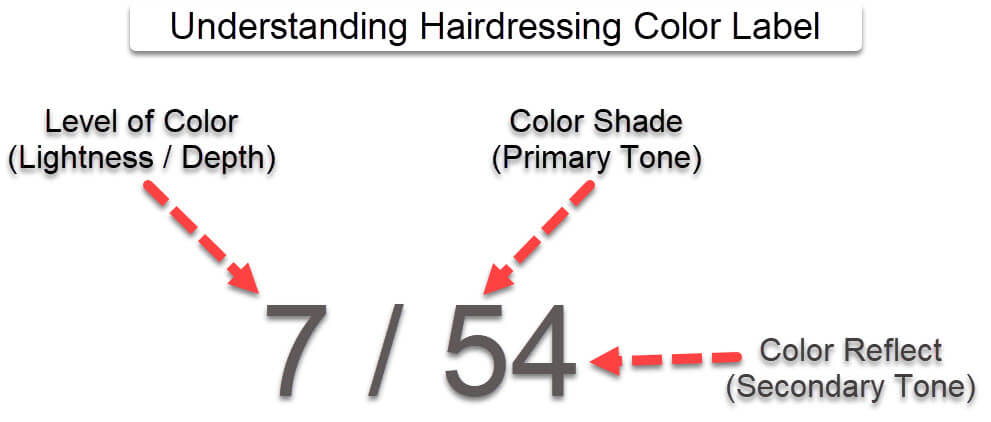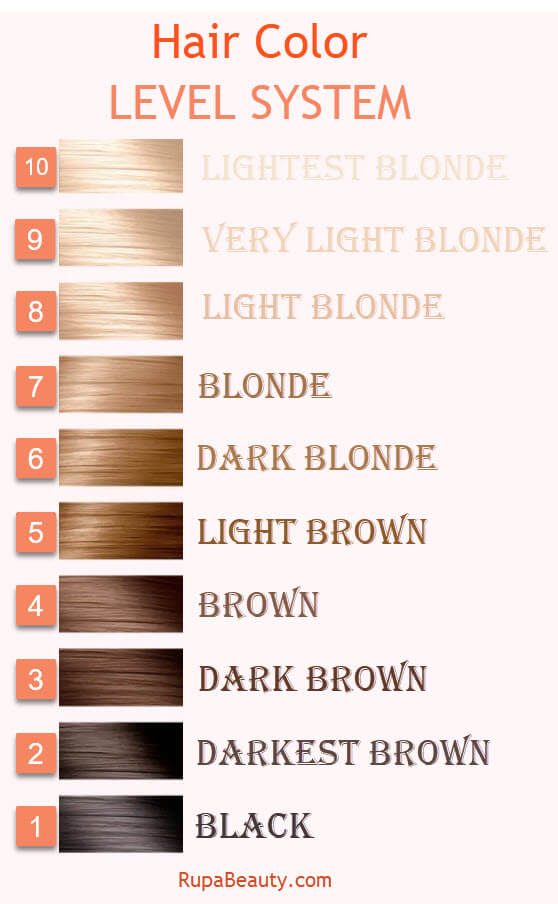Hair tints are usually labeled with a code and a description. It provides us an indication of how dark the color is and what tones the finished color would be. There is a worldwide numbering system, as well as an in-house system used by many brands. Today we will understand What is Level System and Numbering System in Hair Color
Table of Contents
What is Level System and Numbering System In Hair Color
The level system of hair colour is a worldwide approach for standardising hair colour charts that are used by colorists, cosmetologists, and hair colour producers. Your level simply indicates the lightness or darkness of your hair; the darker the hair, the lower the number.
Speaking in terms of levels can help clarify things when it comes to hair colour, because levels are a type of global language that everyone uses, regardless of what hair colour shades are named or how they are defined. To various people, “medium brown hair” signifies different things, but the level is the same or comparable enough across the board. This is why knowing what hair colour level you have now and what hair colour level you desire after colouring is critical so you can select the shade of hair colour that ticks all of your boxes.
Understanding Colour Charts
Numbers or combinations of numbers and letters are frequently used to label professional hairdressing colours:
- The number before the slash (or the decimal point, dash, or dot) is a colour level indication.
- The colour shade is indicated by the first digit following the slash.
- Color reflection is indicated by the following number after the slash.

A dividing sign such as a decimal point, a slash, or a hyphen is generally used to divide the depth number from the tone number. In terms of the ICC, for example, 4.6, 4/6, and 4-6 all mean the same thing. In plain English, a 4.6 means “a medium brown foundation with a warm red tone.”
However, not all hair colour companies utilise the ICC, preferring instead to use their own numerical system. For example, letters might stand for distinct tones, such as R for red, M for mahogany, and V for violet.
Even if a company uses the ICC standard, the final colour may differ from one product to the next. It implies that the number 4.15 on one brand’s hair may differ somewhat from the number 4.15 on another brand’s hair.
The ICC isn’t perfect, but it goes a long way toward standardising how we describe hair colouring products.
Understanding Depth Number
- A full number from 1 to 10 is assigned to depth, with 1 being the darkest hair colour (black) and 10 denoting the lightest (lightest blonde).
- To accommodate for the blondest of the blondes, several companies utilise 11 and 12 in their colouring products. Numbers 1-5 are browns, while numbers 6-10 are blondes, as seen in the diagram below.
- The depth is sometimes referred to as the level or the foundation colour.
- Depth is a colour that is classified as neutral.

Understanding Tone Number
- The decimal point is followed by the tone number.
- Each tone is assigned a number ranging from.1 to.9.
- Those can have up to three tones, although the most frequent are products with one or two tones. The number of decimal places after the decimal point indicates the number of tones in a product.
Understanding Primary & Secondary Tones
- The first number following the decimal point is the primary tone.
- The second number after the decimal point is the secondary tone.
- A main tone is more prominent than a secondary tone and has a greater effect on the final colour. Similarly, any third tone utilised will have a less impact on the final colour than the other two tones.
Importance of Level System
The Hair Color Level system is a standardised hair charting method used by colorists, hairdressers, and hair colour suppliers. It describes the lightness or darkness of one’s hair colour; the lower the number, the darker the hair. Regardless of what hair colour shades are termed or defined as the Hair Level chart makes it easy to relate to. To achieve the greatest results from hair colouring, one must first determine what hair colour level they have and what they desire. Unprocessed hair, for example, is denser and less absorbent to hair colour, reflecting just a little tinge of the colour applied. It may also fade off sooner than expected. Hair with lighter colours absorbs colours more effectively and produces more vivid effects.
Instead of going through the painstaking procedure of identifying your hair’s base colour, state the hair colour level and relax!
While Lightening your Hair Color
If your hair is virgin, permanent hair colour can be used up to a few levels (each line is slightly different).
Permanent hair colour, on the other hand, cannot be used to lift already coloured hair. It is necessary to apply bleach (lightener). And that is why it is SO IMPORTANT that you tell the hairdresser if you have previously coloured your hair.
Permanent hair colour can also only provide a limited amount of lift, generally 1-3 levels. The following stage is high-lift hair colour, which will lift 3-5 levels, and a lightener will be required if you wish to elevate 5 or more levels.
While Darkening your Hair Color
A decrease in hair colour levels indicates that the hair is darkening. While this may appear to be a simple task, inexperience causes numerous complications.
If you want to go from a level 10 platinum blonde to a level 3 dark brown, you Couldn’t just use a level 3 brown on the blonde.
The hair would develop a murky green tint and fade quickly to a colour that was much more unattractive.
While Filling
Rather than merely slapping on the level 3 brown, the hair must first be filled. This is a toner that is used to the hair before the application of the level 3 brown.
You use the underlying pigment to fill in the gaps in the hair. So, if you were a level 10 and wanted to go to a level 3, you’d have to fill your hair with red first.
I’d use a level 5-7 red, red-copper, or red-violet on the hair depending on the desired tone of the level 3. You may then apply your level 3 brown once it has been applied, processed, and washed off.
It is feasible to add the filler to the brown recipe if you simply want to darken it somewhat. However, you must be careful not to use too much filler in order to avoid changing the ideal hair colour tone.
Caution about Hair Bleach
The use of 40 volumes with bleach has been studied extensively.
The stronger the formula, the faster the melanin in the hair shaft dissolves, therefore this is not a good idea. Damage and thinning of the hair shaft may happen as a result of this. When you use a 20 volume developer or a 30 cream developer with bleach, the slower processing time allows the bubbles created to leave the hair shaft’s cuticle layer, allowing the melanin in the cortex to be dissolved/distributed with little to no harm to the hair shaft’s integrity.
Experiment with hair swatches of 20, 30, and 40 volume (along with your bleach) applied to different swatches at the same time, with the same amount of heat, and you’ll be surprised to discover that the 20 volume developer effectively lightens the hair with the same amount of heat like the 40 volume developer, but with less damage.

Creative, versatile, and passionate about her craft, Rupa Das is a well-recognized name in the world of fashion and makeup! This is a woman who has been in the fashion and makeup industry for 24 years and is still one of the leading international makeup artist in the circuit! She has worked in big brands like Lakme, Green Trends, Colors and transitioned to become a Beauty (Hair & Skin) Trainer.